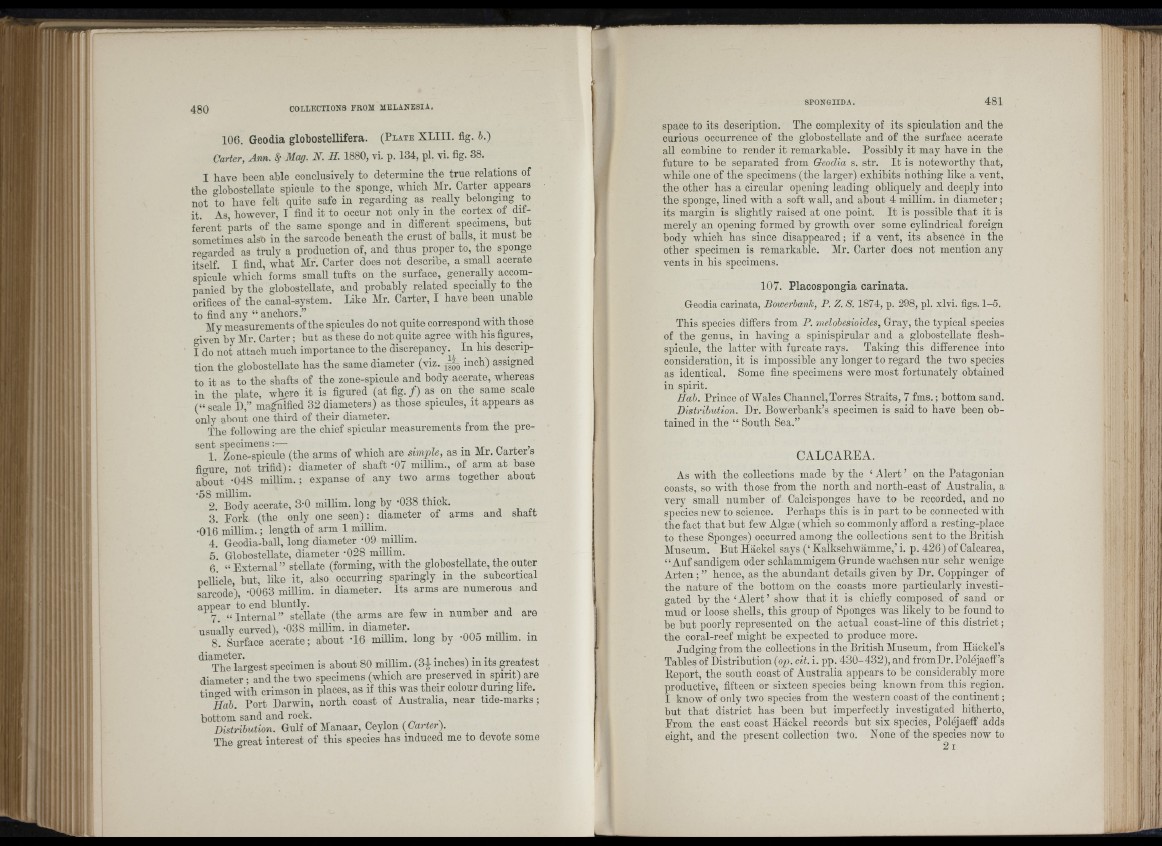
106. Geodia globostellifera. ( P l a t e X L III. fig. b.)
Carter, Ann. Mag. N. II. 1880, vi. p. 134, pi. vi. fig. 38.
I have been able conclusively to determine the true relations of
the o-lobostellate spicule to the sponge, which Mr. Carter appears
- - • not tLoU hiliaLvVDe fICeilUt ---q-u-'-i-t -e-- -s-a-f-e- --i-n-- - -r-e-g--a--r-d--i-nog as_ -re1a1lly-./ belon"ging ttno
it. As, however, I find it to occur not ouly in the cortex oi dit-
ferent parts of the same sponge and in different specimens, hut
sometimes also in the sarcode beneath the crust of balls, it must be
regarded as truly a production of, and thus proper to, the sponge
itsd f. I find, what Mr. Carter does not describe, a smaU acerate
spicule which forms small tufts on the surface, generally accompanied
by the globostellate, and probably related specially to the
orifices of the canal-system. Like Mr. Carter, I have been unable
to find any “ anchors.”
My measurements of the spicules do not quite correspond with those
o-iven by Mr. C a rte r; but as these do not quite agree with his figures,
I do not attach much importance to the discrepancy. ^ In his description
the globostellate has the same diameter (viz. UU inch) assigned
to it as to the shafts of the zone-spicule and body acerate, whereas
in the plate, where it is figured (at fig. / ) as on ihe same scale
( “ scale D,” magnified 32 diameters) as those spicules, it appears as
only about one third of their diameter.
The following are the chief spicular measurements from the present
specimens:— . • nr n ’
1 Zone-spicule (the arms of which are simple, as in JHr. Garter s
fiaui-e, not trifid): diameter of shaft -07 millim., of arm a t base
about’ -048 millim.; expanse of any two arms together about
^ 2. Body acerate, 3-0 millim. long by -038 thick.
3. Fork (the only one seen ): diameter of arms and shaft
•016 millim.; length of arm 1 millim. _
4. Geodia-hall, long diameter -09 millim.
5. Globostellate, diameter -028 millim. „ ,
6 “ E x te rn a l” stellate (forming, with the globosteUate, the outer
pellicle, bnt, like it, also occurring sparingly in the subcortical
Lrcode), -0063 miUim. in diameter. Its arms are numerous and
appear to end bluntly. . . . -u j
7 “ In te rn a l” stellate (the arms are few m number and are
usimlly curved), -038 miUim. in diameter. _
8. Surface acerate; about -16 millim. long by -005 millim. in
*^^The largest specimen is about 80 millim. (3^ inches) in its greatest
diameter ;”and the two specimens (which are preserved m spirit) are
tino-ed with crimson in places, as if this was their colour during life.
Hah Port Darwin, north coast of Australia, near tide-marks;
b o ttom sand and rock. ^
Distrihution. Gulf of Manaar, Ceylon (Carter).
The great interest of this species has induced me to devote some
space to its description. The complexity of its spiculation and the
curious occurrence of the globostellate and of the surface acerate
all combine to render it remarkable. Possibly it may have in the
future to be separated from Oeodia s. str. I t is noteworthy that,
while one of the specimens (the larger) exhibits nothing like a vent,
tho other has a circular opening leading obliquely and deeply into
the sponge, lined with a soft wall, and about 4 millim. in diameter;
its margin is slightly raised at one point. I t is possible th at it is
merely an opening formed hy growth over some cylindrical foreign
body which has since disappeared; if a vent, its absence in the
other specimen is remarkable. Mr. Carter does not mention any
veuts in his specimens.
107. Placospongia carinata.
Geodia carinata, Bowerbank, P. Z. S. 1874, p. 298, pi. xlvi. figs. 1-5.
This species differs from P. melohesioides. Gray, the typical species
of the genus, iu having a spinispirular and a globosteUate flesh-
spicule, the latter with furcate rays. Taking this difference into
consideration, it is impossible any longer to regard the two species
as identical. Some fine specimens were most fortunately obtained
in spirit.
Hab. Prince of Wales Channel, Torres Straits, 7 fms.; bottom sand.
Distrihution. Dr. Bowerbank’s specimen is said to have been obtained
in the “ South Sea.”
f ill,
CALCAREA.
As with the collections made by the ‘A le rt’ on the Patagonian
coasts, so with those from the north and north-east of Australia, a
very small number of Calcisponges have to he recorded, and no
species new to science. Perhaps this is in part to be connected with
the fact th at but few Algae (ivhich so commonly afford a resting-place
to these Sponges) occurred among the collections sent to the British
Museum. But Hackel says (‘ Kalkschwamme,’ i. p. 426) of Calcarea,
“ Anfsandigem oder schlammigem Grunde wachsen niir sehr wenige
A rte n ; ” hence, as the abundant details given by Dr. Coppinger of
the nature of the bottom on the coasts more particularly investigated
by the ‘A le rt’ show th at it is chiefly composed of sand or
mud or loose shells, this group of Sponges was likely to he found to
he hut poorly represented on the actual coast-line of this d istric t;
the coral-reef might be expected to produce more.
Judging from the collections in the British Museum, from Hiickel’s
Tables of D istribution (op. cit. i. pp. 430-432), and fromDr.Polejaeff’s
Report, the south coast of Australia appears to be considerably more
productive, fifteen or sixteen species being known from this region.
I know of only two species from the western coast of the continent;
but th a t district has been but imperfectly investigated hitherto,
From the east coast Hackel records but six species, Polejaeff adds
eight, and the present collection two. None of the species now to
2 I